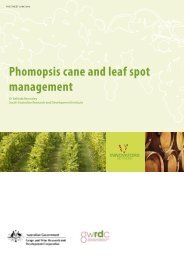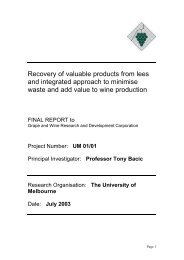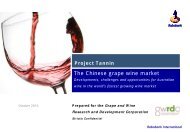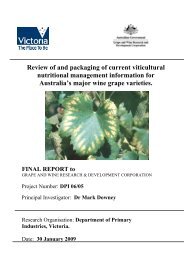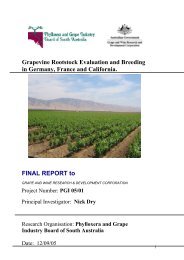Identification of the major drivers of 'phenolic' taste in ... - GWRDC
Identification of the major drivers of 'phenolic' taste in ... - GWRDC
Identification of the major drivers of 'phenolic' taste in ... - GWRDC
You also want an ePaper? Increase the reach of your titles
YUMPU automatically turns print PDFs into web optimized ePapers that Google loves.
AWRI: <strong>Identification</strong> Of The Major Drivers Of ‘Phenolic’ Taste In White W<strong>in</strong>es<br />
harvest<strong>in</strong>g and greater maceration are associated with any specific sensory attributes, or with general<br />
conformance to a particular style.<br />
4.2.2 Study 2: Effect on Riesl<strong>in</strong>g Style and Perceived Quality<br />
Riesl<strong>in</strong>g is <strong>the</strong> fourth most important Australian white grape variety <strong>in</strong> 2010 <strong>in</strong> terms <strong>of</strong> production (ABS<br />
Cat. 1329.0). Dry Riesl<strong>in</strong>g styles vary substantially - from <strong>the</strong> light bodied, low alcohol, high acid styles<br />
typical <strong>of</strong> <strong>the</strong> Ruhr/Rh<strong>in</strong>e region <strong>of</strong> Germany through to fuller bodied, higher alcohol styles typical <strong>of</strong> <strong>the</strong><br />
Alsatian region <strong>of</strong> France. Australian producers have generally produced leaner, aromatic w<strong>in</strong>es with<br />
higher acidity <strong>in</strong> <strong>the</strong> Germanic style. In order to preserve <strong>the</strong> varietal character, Australian w<strong>in</strong>emakers<br />
have generally avoided w<strong>in</strong>emak<strong>in</strong>g strategies that could potentially contribute to <strong>the</strong> phenolic content <strong>of</strong><br />
<strong>the</strong> f<strong>in</strong>ished w<strong>in</strong>e (McLean, 2005).<br />
4.2.3 Study 3: Effect on Perceived Quality and Consumer Acceptance<br />
<strong>of</strong> Commercial Dry White W<strong>in</strong>es<br />
The importance <strong>of</strong> phenolic content <strong>in</strong> dry white w<strong>in</strong>es compared with o<strong>the</strong>r aspects <strong>of</strong> <strong>the</strong>ir composition<br />
such as alcohol, acidity and residual sugar is unknown. Here we <strong>in</strong>vestigate <strong>the</strong> role <strong>of</strong> phenolic content<br />
on w<strong>in</strong>emaker perceived quality and consumer acceptability <strong>of</strong> commercial dry white w<strong>in</strong>es.<br />
4.3 Methods<br />
4.3.1 Study 1: Effect on ‘P<strong>in</strong>ot G’ Style<br />
W<strong>in</strong>e samples<br />
22 commercial P<strong>in</strong>ot Gris/P<strong>in</strong>ot Grigio w<strong>in</strong>es that made up <strong>the</strong> tra<strong>in</strong><strong>in</strong>g set for <strong>the</strong> AWRI’s P<strong>in</strong>ot Gris<br />
style project were used - 18 were Australian, three were from Alsace, France and one was from New<br />
Zealand. They formed a diverse set <strong>of</strong> styles represent<strong>in</strong>g that variety, rang<strong>in</strong>g from a fuller bodied,<br />
higher alcohol style typically labeled <strong>in</strong> <strong>the</strong> marketplace as ‘Gris’, to <strong>the</strong> lighter bodied, lower alcohol,<br />
high acid style typically labeled as ‘Grigio’. The ‘Grigio’ style that typifies Italian examples <strong>of</strong> <strong>the</strong><br />
varietal, contrasts with <strong>the</strong> ‘Gris’ style that is typified by w<strong>in</strong>es <strong>of</strong> Alsatian orig<strong>in</strong>.<br />
The <strong>taste</strong>rs and sensory methods<br />
The panel consisted <strong>of</strong> ten experienced <strong>taste</strong>rs who were members <strong>of</strong> an AWRI tast<strong>in</strong>g panel. They all had<br />
between 5 and 25 years cont<strong>in</strong>uous tast<strong>in</strong>g experience as part <strong>of</strong> <strong>the</strong>ir pr<strong>of</strong>ession and had undertaken <strong>the</strong><br />
AWRI’s Advanced W<strong>in</strong>e Assessment Course. Around half <strong>the</strong> <strong>taste</strong>rs also had w<strong>in</strong>emak<strong>in</strong>g qualifications<br />
and/or had some practical w<strong>in</strong>emak<strong>in</strong>g experience.<br />
Page | 31




